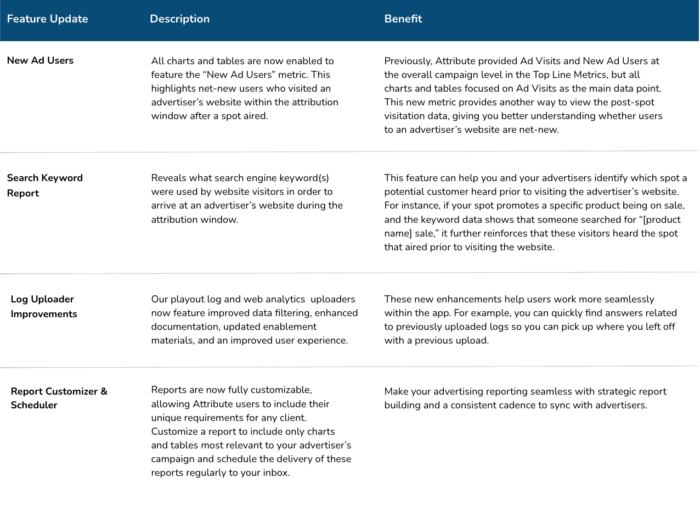With the dawn of digital advertising came the opportunity to track every interaction, measure each conversion, and quickly adjust strategies to create the most optimal performance. While marketers and brands were seeing an influx of data for their digital advertising campaigns, it became difficult to measure the impact of TV ads.
Now, thanks to certain attribution tools, advertisers can gather far more information than what was possible before.
In the previous blog, we discussed TV advertising trends and mentioned the importance of attribution metrics and how they can help advertisers get the most out of their ad campaigns. In this final blog of our Complete Guide to TV Advertising in 2025 and Beyond series, we’re going to expand on that idea and cover:
- What is TV advertising attribution?
- How attribution benefits TV broadcasters
- Why traditional attribution tools are failing
- Highlight a solution that offers broadcast-to-web attribution
What is TV advertising attribution?
Television attribution is a newer iteration of attribution data science disciplines. Attribution got its start in digital marketing and was swiftly adopted by advertisers because of its ability to deliver granular, actionable metrics regarding campaign performance in real-time.
TV ad attribution and other broadcast attribution measure immediate, measurable actions in response to advertisements, like searching for particular websites, brands, or keywords. Attribution looks at the spike in online response volume after the ad airs, which advertisers can analyze to gain insight into the ad’s performance.
An attribution model has a set of rules that determines how sales and conversion credits are assigned to touchpoints in the conversion path. There are many types of attribution models, including:
- First-touch attribution: A simple model that assigns a single source 100% of the credit to the first point of contact a customer makes.
- Last-touch attribution: Similar to first-touch attribution, but 100% of the credit goes to the customer’s most recent interaction.
- Last non-direct touch attribution: Best used for a short-buying cycle, this model assigns all credit to a single interaction without considering direct traffic as an attributable channel.
- Linear attribution: This model credits multiple touchpoints and weighs all of them equally, which is great for measuring overall campaign effectiveness.
- Time-decay attribution: A model that distributes credit across multiple events but assigns more credit to the actions that happened closer to the time of conversion.
Regardless of the chosen model, without validation data, proper assessment is nearly impossible, so finding the right analytic solution is key. Because of the complex relationship between broadcast and digital, TV attribution models have been elusive in the past, especially in regards to getting a comprehensive view of consumer behavior across different channels and devices. Certain technological advancements have offered solutions to these problems, and we’ll explore those later in this blog.
What’s in it for TV broadcasters?
Though the perks of attribution most clearly benefit advertisers, TV broadcasters can also benefit from this data. Broadcast TV ads are still one of the most effective ways to widen brand awareness, but broadcasters have recently seen a dip in ad revenue. That’s because it’s difficult to prove the advertising works in a clear-cut, measurable way. Compare that with digital, where it’s fairly simple to track conversions, clicks, impressions, and more.
TV attribution technology bridges the rift between digital and broadcast so that broadcasters can provide clear evidence for the effectiveness of TV ads. By doing so, broadcasters can not only prove their ads work; they can help advertisers optimize their campaigns, which helps them win renewals and generate more revenue.
This is especially important given the current media landscape. In 2019, eMarketer forecasted that US advertisers would spend $70.30 billion on TV that year, which marked a 2.9% decrease from 2018. However, Standard Media Index reveals that TV spending is up 9% from Jan. 2021, 0.1% greater than Jan. 2020, right before the pandemic—meaning that now is the time for broadcasters to step up and ensure their advertisers know the value they get from TV advertising.
How are traditional solutions failing?
Previously, TV ad recall and impact required the fairly simple measure of gathering surveys, but these present certain issues. It’s difficult to measure an ad’s behavioral impact, like actions leading up to a sale or the sale itself, and these surveys don’t really offer those kinds of measurement solutions.
Surveys are self-reported, meaning that there could be a lack of precision, and are often conducted a while after the purchase outcome. What’s more, they don’t reflect customer behavior, which holds invaluable information for advertisers.

Traditional solutions for TV attribution simply can’t keep up with the possibilities of digital ad attribution. It’s a challenge to disentangle integration problems and understand data matches that are “good enough.”
What we’re seeing is that the issue with TV attribution has been a data problem, until now. Due to unique challenges, the success of TV attribution has depended on sufficient data—not optimal data.
Gain insight into TV ads with Veritone Attribute
Broadcasters and advertisers are in need of a purpose-built solution that can provide accurate insights into the effectiveness of advertising strategies and campaigns. With most solutions, it’s not possible to collect enough online data and connect it to a specific TV ad campaign, but Veritone Attribute is changing that.
Veritone Attribute, powered by Veritone aiWARE, a hyper-expansive Enterprise AI platform, measures the impact of an advertising campaign by correlating broadcast ads with web traffic. By connecting to website analytics, broadcasters and advertisers can connect advertising campaigns, spots, and in-content placements to actions that their target audience has made on their website.
Veritone Attribute’s capabilities pair with website activity so users can get near real-time response insights and gain visibility on their ad’s geographic, broadcast, placement, and creative performance. This allows advertisers to become better informed on the effectiveness of their ads, so they can deliver their optimal strategy, drive customer satisfaction, maintain budget, and see a greater ROI.
See the latest Veritone Attribute updates

By using Veritone Attribute for TV ad tracking, advertisers can gain a strong advantage, which can be maximized when used with Veritone’s other AI-enabled solutions for TV, such as Veritone Discovery and Veritone Digital Media Hub.
Learn more about Veritone’s proven AI solutions for TV stations. Contact us here, or reach out to your Veritone sales rep.